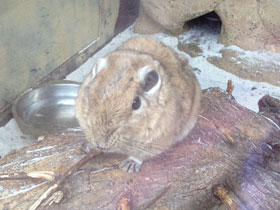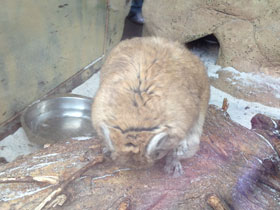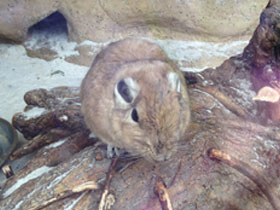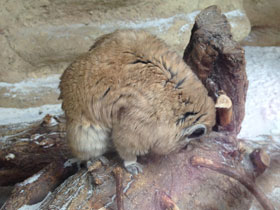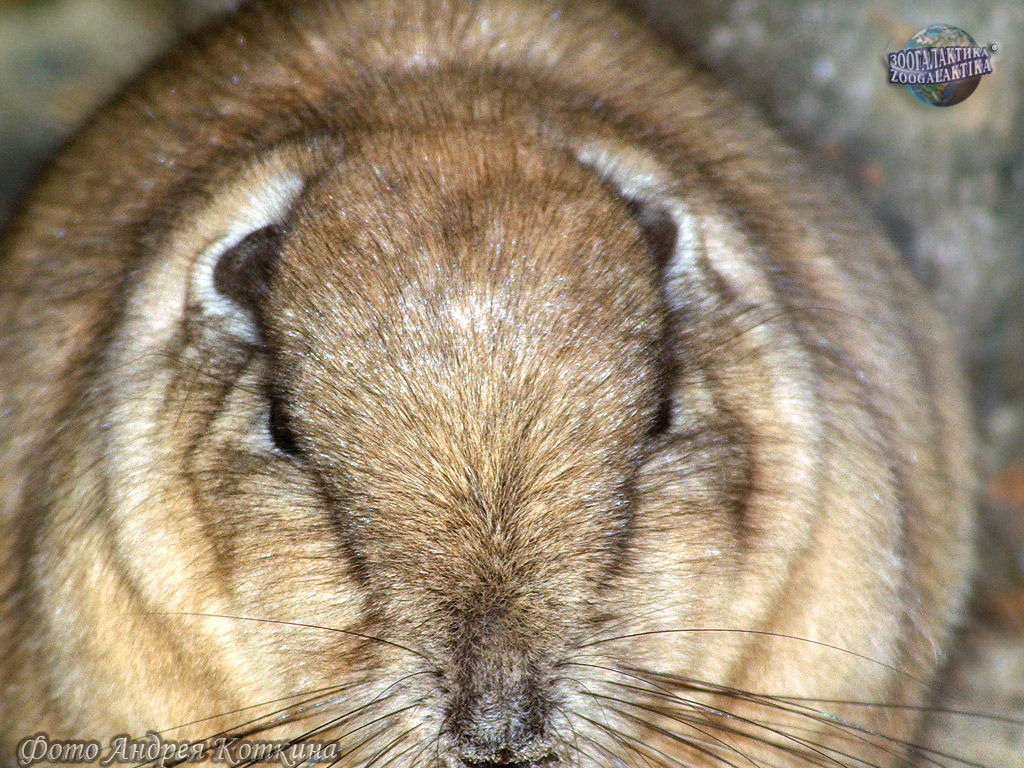Gundis or comb rats (family Ctenodactylidae)
The common gundi (Ctenodactylus gundi)
Gundis or comb rats (family Ctenodactylidae) are a group of small, stocky rodents found in Africa. They live in rocky deserts across the northern parts of the continent. The family comprises four living genera and five species (Speke's gundi, Felou gundi, Val's or desert gundi, common or North African gundi and Mzab gundi), as well as numerous extinct genera and species. They are in the superfamily Ctenodactyloidea. Local people in northern Africa have always known about gundis, however they first came to the notice of western naturalists in Tripoli in 1774, and were given the name gundi mice. While they are not regarded as pests, some people hunt gundis for food.
Description
The body of these North African rodents is dense and curvaceous; the muzzle is short with long vibrissae, the ears are short and rounded, and the eyes are large. Externally, they somewhat resemble guinea pigs or pika. The body length of Ctenodactylidae varies from 16 to 24 cm, tail length 1-5 cm; their weight varies from 170 to 200 g. Their limbs are short and strong, with bare soles; each has 4 toes armed with short but very sharp claws.
Ctenodactylidae got their name from the characteristic peculiar brush of two rows of stiff horny bristles and one row of soft hair-like white bristles located above the toes of the hind legs. This comb helps them break up loose sand and run across it. The hair cover of Ctenodactylidae is soft, silky and dense; most are brown or grey in colour.
Habitat
Ctenodactylidae are distributed in the rocky mountains and semi-deserts of North Africa, from Morocco and Senegal to Somalia. These rodents are herbivorous. They are active mainly at dusk or during the day (but then the animals maintain body temperature by constantly running from sunny areas to shade). Ctenodactylidae usually live in colonies.
Taxonomy
- Ctenodactylidae;
- Ctenodactylus;
- Common gundi, Ctenodactylus gundi;
- Val's gundi, Ctenodactylus vali;
- Felovia;
- Felou gundi, Felovia vae;
- Massoutiera;
- Mzab gundi, Massoutiera mzabi;
- Pectinator;
- Speke's pectinator, Pectinator spekei.
The common gundi (Ctenodactylus gundi)
The common gundi (Ctenodactylus gundi) is a species of rodent in the family Ctenodactylidae. It is found in Algeria, Libya, Morocco, and Tunisia. The parasitic organism Toxoplasma gondii was first described in 1908 in Tunis by Charles Nicolle and Louis Manceaux within the tissues of the gundi.
Description
The common gundi grows to a length of between 16 and 20 cm (6.3 and 7.9 in), having a stumpy tail of 10 to 20 mm (0.4 to 0.8 in). A gundi weighs about 185 g (6.5 oz). It resembles a guinea pig in appearance, having big eyes, flat ears and short limbs. Each foot has four digits and sharp, dark claws; the two hind feet have comblike bristles between the claws. Gundi's teeth are rootless.
Distribution
Ctenodactylus gundi inhabits the flat and lowland (up to 2,400 metres above sea level) stony deserts and semi-deserts of northern Africa. These rodents are found in northern Algeria, south-eastern Morocco, Tunisia and Libya. Their compact bodies vary from 16 to 20 cm in length, their legs are short, their ears are flat, their eyes are large, and their whiskers are long. The animal is covered with very soft fluffy fur of pinkish-yellow colour, similar in softness to chinchilla fur. Ctenodactylus gundi deftly run and climb bare rocks, climb almost vertical walls. Their toes have bare, convex pads on their toes, which aid in running on rocks. Gundi find shelter in cracks, crevices and under rocks, but they do not dig holes. In winter they huddle together to stay warm.
Lifestyle and habits of Ctenodactylus gundi
Shortly after sunrise, the voice of Ctenodactylus gundi can be heard among the rocks - a peculiar whistle and squeak, similar to the cries of small birds. Crawling out of their shelters and looking around carefully, gundi first bask in the sun until their body temperature reaches 20°C, and then start eating. They feed on a variety of grains, seeds and fruits. The chewing muscles of gundies are poorly developed due to their tendency to eat mainly soft food. Ctenodactylus gundi do not drink water, obtaining the necessary moisture from the plants they consume. Once satiated, they proceed to toilet: thoroughly comb their fur with comb-like bristles of the hind legs. Then they sunbathe again: they spread themselves out on a flat stone and lie motionless for a long time under the rays of the morning sun. When the sun rises high and the heat sets in, gundis hide in their shelters and reappear when the heat subsides - in the predawn hours.
Social behaviour
Ctenodactylus gundi live in small families of 3 to 11 adults, of which one to three are males. These rodents have no defined territories and while searching for food, the animals wander into neighbours' territories without causing any incidents. In the event of an alarm, the gundi rises on its hind legs, looks round and, spotting danger, hides in a crevice with a short, alarming whistle.
Breeding
The breeding season of Ctenodactylus gundi is in spring and early summer. The female brings one or two litters per year, giving birth to 1 to 4 cubs. Pregnancy lasts about 8 weeks, the cubs are born fully developed and, although they remain with their mother for several weeks, they begin to chew grass at the age of 3-4 days. The gundi's life expectancy is up to 5 years.
Status
The common gundi is a fairly common species with a wide range, and no particular threats have been identified. Its abundance varies according to the amount of precipitation that falls; in the west of its range it is replaced by Val's gundi (Ctenodactylus vali) in dry years. The International Union for Conservation of Nature has assessed it as being a species of "least concern".










